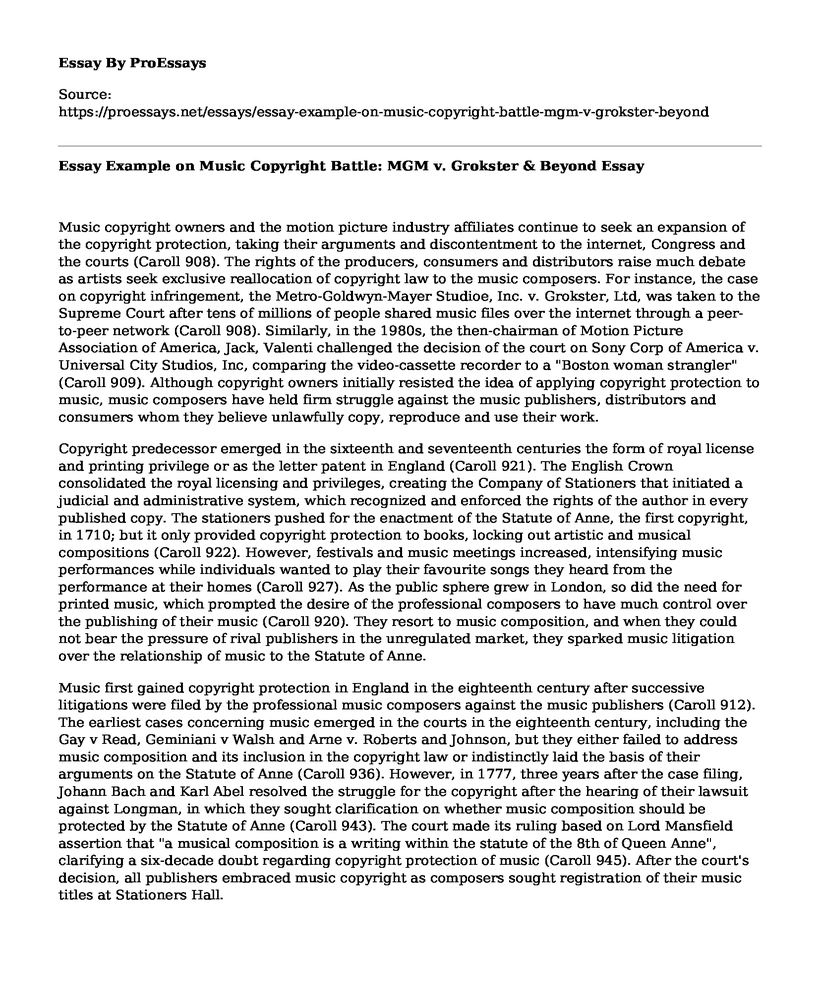Music copyright owners and the motion picture industry affiliates continue to seek an expansion of the copyright protection, taking their arguments and discontentment to the internet, Congress and the courts (Caroll 908). The rights of the producers, consumers and distributors raise much debate as artists seek exclusive reallocation of copyright law to the music composers. For instance, the case on copyright infringement, the Metro-Goldwyn-Mayer Studioe, Inc. v. Grokster, Ltd, was taken to the Supreme Court after tens of millions of people shared music files over the internet through a peer-to-peer network (Caroll 908). Similarly, in the 1980s, the then-chairman of Motion Picture Association of America, Jack, Valenti challenged the decision of the court on Sony Corp of America v. Universal City Studios, Inc, comparing the video-cassette recorder to a "Boston woman strangler" (Caroll 909). Although copyright owners initially resisted the idea of applying copyright protection to music, music composers have held firm struggle against the music publishers, distributors and consumers whom they believe unlawfully copy, reproduce and use their work.
Copyright predecessor emerged in the sixteenth and seventeenth centuries the form of royal license and printing privilege or as the letter patent in England (Caroll 921). The English Crown consolidated the royal licensing and privileges, creating the Company of Stationers that initiated a judicial and administrative system, which recognized and enforced the rights of the author in every published copy. The stationers pushed for the enactment of the Statute of Anne, the first copyright, in 1710; but it only provided copyright protection to books, locking out artistic and musical compositions (Caroll 922). However, festivals and music meetings increased, intensifying music performances while individuals wanted to play their favourite songs they heard from the performance at their homes (Caroll 927). As the public sphere grew in London, so did the need for printed music, which prompted the desire of the professional composers to have much control over the publishing of their music (Caroll 920). They resort to music composition, and when they could not bear the pressure of rival publishers in the unregulated market, they sparked music litigation over the relationship of music to the Statute of Anne.
Music first gained copyright protection in England in the eighteenth century after successive litigations were filed by the professional music composers against the music publishers (Caroll 912). The earliest cases concerning music emerged in the courts in the eighteenth century, including the Gay v Read, Geminiani v Walsh and Arne v. Roberts and Johnson, but they either failed to address music composition and its inclusion in the copyright law or indistinctly laid the basis of their arguments on the Statute of Anne (Caroll 936). However, in 1777, three years after the case filing, Johann Bach and Karl Abel resolved the struggle for the copyright after the hearing of their lawsuit against Longman, in which they sought clarification on whether music composition should be protected by the Statute of Anne (Caroll 943). The court made its ruling based on Lord Mansfield assertion that "a musical composition is a writing within the statute of the 8th of Queen Anne", clarifying a six-decade doubt regarding copyright protection of music (Caroll 945). After the court's decision, all publishers embraced music copyright as composers sought registration of their music titles at Stationers Hall.
Conclusion
The extension of copyright protection of music enabled composers to produce their songs independently to support their work without relying on market exchange. Although the Statute of Anne granted all composers the legal rights to publish their art for profit, professional composers, amateurs and performers produced music under their terms with the liberty to borrow from other artworks (Caroll 957). However, in the contemporary artwork, the traditional borrowing has been restricted, as use of any prior music component such as a sequence of previous recording results in litigation (Caroll 957). Additionally, the modern copyright protects public performances requiring any individual to seek the permission of the copyright holder before performing their songs as they have no right to rob the composers of their rightful profits (Caroll 958). The internet has further enabled professional composers to actively and directly engage in copyright law.
Work Cited
Caroll W. Michael. "The struggle for music copyright." Florida Law Review, vol. 57. no.4, September 2005, p.907-962.
Cite this page
Essay Example on Music Copyright Battle: MGM v. Grokster & Beyond. (2023, Jul 02). Retrieved from https://proessays.net/essays/essay-example-on-music-copyright-battle-mgm-v-grokster-beyond
If you are the original author of this essay and no longer wish to have it published on the ProEssays website, please click below to request its removal:
- Effect of Media Networking on Social Interaction and Work - Research Paper Sample
- El Angel Exterminator Film Review
- Mary Belle Harris Biography
- Article Analysis Essay on Morality, Ethics, and Digital Life
- My Role Model Musician: Antonio Vivaldi - Essay Sample
- Marketing With Social Media: Increasing Brand Awareness - Dissertation Example
- Essay Example on Phenomenal Nancy Pelosi, America's Most Powerful Woman Speaker







